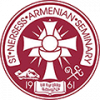Two Halves of the Badarak
In all of the ancient churches, the Divine Liturgy consists of two large blocks: the Synaxis (bashdon jashou), and the Eucharist (ganon srpo badaraki). In the Armenian badarak these two halves are preceded by a preparatory introduction, and followed by a brief conclusion - both late additions to the ancient two-part structure.
The Synaxis, which means "assembly," or "gathering together," is often called the "Liturgy of the Word" because this part of the Divine Liturgy centers on the reading of passages from the Bible, especially the Holy Gospel. The Armenian Church fathers always emphasize that in the reading of the Gospel, Jesus Christ Himself is revealed. Around the turn of the eighth century, the Armenian theologian Stepanos of Siunik (d. 735) wrote: "It is not a delegate who pronounces the Gospel, or even an angel, but the Lord of heaven and earth Himself, saying, 'I came from the Father and have come into the world' [Jn 16:28]." Christ is revealed in the Gospel reading and this corresponds to His revelation by His Body and Blood in Holy Communion.
The Synaxis has its roots in the ancient Jewish synagogue service. The earliest Christians were Jewish converts, and at least until the early second century they continued the liturgical traditions of their forefathers - reinterpreting them, however, in the spirit of the new Christian faith. St. Justin the Martyr (d. 165) describes a Christian synaxis of scriptural readings, sermon, common prayers and the kiss of peace, followed by the Eucharist - an outline similar to ours today.
In Armenia, Stepanos of Siunik gives the earliest and most complete account of the Synaxis. He describes a ceremony at the third hour (9:00 a.m.), on the "great day of the resurrection of the Lord" (Sunday). That service begins with a procession into the church to the altar, a procession with the gospel book around the altar while singing "Holy God" (Sourp Asdvadz), a litany, scripture readings, alleluia, the gospel reading, recitation of the Creed, and a closing litany and prayer. This ancient outline corresponds to our Synaxis, except for some minor additions made by the twelfth century.
The Liturgy of the Eucharist: Giving Thanks
The second block of the badarak is called the "Eucharist," a Greek word meaning "thanksgiving." We give thanks to the Lord because He has saved us and cares for us. The heart of the Eucharist in all ancient Christian traditions is called the Anaphora or Eucharistic Prayer (khorhrtamadouyts or kohoutyan aghotk). This long prayer is recited by the priest on behalf of all the people.
Each of the ancient churches has its own repertoire of individual eucharistic prayers which are similar in literary structure and theme, but vary in content. Most of them are quite ancient and bear the names of great church fathers. The eucharistic prayer used every Sunday in the Armenian Church throughout the world is attributed to St. Athanasius, the fourth-century Egyptian theologian who greatly inspired Armenian theological thinking. The Anaphora of St. Athanasius reflects the individuality of the Christian faith as experienced in Armenia. It brings together all of the themes of the Divine Liturgy: thanksgiving, worship, commemoration, sacrifice, Holy Communion, and the celebration of our salvation.
In the Divine Liturgy, the church takes unleavened bread and wine and offers these to God. We ask that He sanctify them by His Holy Spirit and change them into the Body and Blood of Jesus Christ, a means for our communion with Him. The Armenian Church believes that when we receive Holy Communion, we are not eating mere bread and wine. By the power of God, we are receiving Christ Himself, as He commanded us, in a manner which, we admit, is beyond our comprehension.
Holy Communion is a sign of the union of each member of the church with the other and with God. When a piece of bread is broken into small pieces and distributed to the members of a group to eat, it is an act of unification: that piece of bread that was once whole is now shared by the members of the group. It brings them together. Sharing a single cup of wine has the same meaning. When that bread is not just bread, but Christ Himself, and when that cup of wine is not just wine, but Christ's life-blood, then we can see the power of this ritual as a real communion ("co-union") with each other and with the Son of God. Having done this, we become the Church, the Body of Christ, in the fullest sense. And this is what Christianity is all about:
The cup of blessing which we bless, is it not a participation in the blood of Christ? The bread which we break, is it not a participation in the body of Christ? Because there is one bread, we who are many are one body, for we all partake of the one bread. (1 Cor 10:16)
Notes by Fr. Daniel Findikyan
